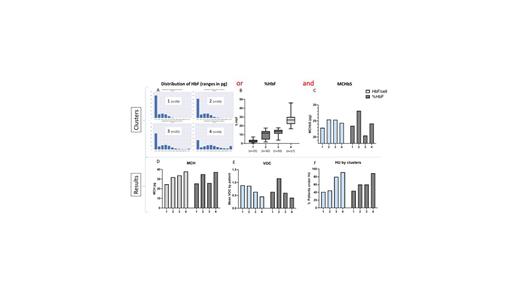Vaso-occlusive crisis (VOC), the main complication of sickle cell disease (SCD), is responsible for more than 50% of the associated deaths. The effect of hydroxyurea, the cornerstone treatment for SCD, on the occurrence of VOC is mainly mediated by increasing HbF levels, which is a protective factor by inhibiting hemoglobin S (HbS) polymerization. 1,2 However, HbF level is variable between patients, and its expression is heterogeneous among the red blood cell (RBC) population. 3 As a result, while an increase in HbF levels is associated with better survival, %HbF only partially explains patients' clinical manifestations. The protective effect of HbF is also related to the HbS content; the more HbS, the more HbF is needed to inhibit its polymerization. In this study, we wondered if the single-cell quantification of HbF that we developed could better explain the VOC incidence of SCD compared to %HbF.
Patients and method
We analyzed data from the FCDREP1 protocol, aiming to obtain a predictive score for VOC at 1 year. Inclusion criteria were SS and S- S-b 0 Thal SCD patients, more than 1 month after a vaso-occlusive crisis, 3 months after a transfusion, and on a stable dose of hydroxyurea (HU) for at least 3 months. After giving their consent (IRB no. 00003835) during a routine blood sampling visit, an additional sample was taken for HbF single cell quantification, providing HbF/cell distribution. VOC were collected prospectively for 1 year. HbF single cell quantification was measured by flow cytometry using a previously published protocol, 4 data are expressed as histograms representing % RBC in each HbF range in pg for the whole cluster. K-means clustering was performed on different combination of variables containing ranges of HbF/cell distribution versus %HbF, with MCHbS (MCH x %HbS) using UMAP for dimensionality reduction (into 2), after we applied Min-Max scaling to preprocess the features, with python 3 on sklearn and umap library. This clustering approach can group data points based on their similarity, providing insights into distinct patterns or subgroups within the dataset.
Results
One hundred two patients were included with a mean age of 38 ± 11 years, a sex ratio F/M of 0.56, 63% of patients were on HU. Patients had a total of 74 VOC with a mean of 0.71 ± 1.4 VOC per patient in the year. Analyses were performed finding 4 different clusters in different 2 groups. Group 1: clusters identified by the association of HbF/cell distribution and MCHbS (HbF/Cell) and Group 2: clusters identified by %HbF and MCHbS (%HbF). Clusters were numbered according to increasing HbF levels (Figure 1A and B). There was no significant difference in age or sex ratio between the groups whereas the percentage of patients on HU differed between groups (Figure 1F). The number of patients by cluster was also similar.
Cluster analysis of Group 1 showed a decrease in VOC incidence (Figure 1E, blue bars) associated with an increase in HbF level per RBC (Figure 1A). If clusters 1 and 2 are similar regarding the % of HU-treated patients, cluster 1 shows a lower HbF/cell content (Figure 1A) but lower MCHbS and MCH (Figure 1C and 1D), possibly explaining a similar VOC incidence in the 2 clusters. With a higher % of HU-treated (Figure 1F), Cluster 3 and 4 stand out from each other by different HbF expression patterns and VOC incidence (Figure 1A).
The clusters of group 2 does not show the same increasing incidence of VOC as a function of median %HbF (Figure 1B and E). If cluster 4, mostly treated with HU, corresponds to patients with high %HbF and low VOC; cluster 1, with little HU treatment and very low %HbF, has few VOCs, not explained by MCHbS. The difference in severity between clusters 2 and 3, which have the same percentage of HU, could be explained by the greater difference in %HbF distribution, with median %HbF values of 11.8 [5-14] and 13.8 [11-15] (p=0.06) respectively, as well as by the low MCHbS of cluster 3.
Conclusion : Single cell quantification of HbF in RBC in association with MCHbS could help improve to better understand VOC incidence.
Disclosures
Bartolucci:Roche: Consultancy; Bluebird: Consultancy; INNOVHEM: Current equity holder in private company; Novartis: Consultancy, Membership on an entity's Board of Directors or advisory committees; Addmedica: Consultancy, Membership on an entity's Board of Directors or advisory committees; Jazz Pharma: Consultancy; GBT: Consultancy; Emmaus: Consultancy. Bencheikh:INNOVHEM: Current Employment. Perkins:INNOVHEM: Current Employment. Rapsode:INNOVHEM: Other: INtern. Habibi:GBT: Consultancy; Add Medica: Honoraria; novartis: Consultancy. De Luna:GBT: Consultancy; VERTEX: Consultancy; Pfizer: Other: Principal Investigator HEMOPROVE trial. Cambot:INNOVHEM: Current equity holder in private company.


